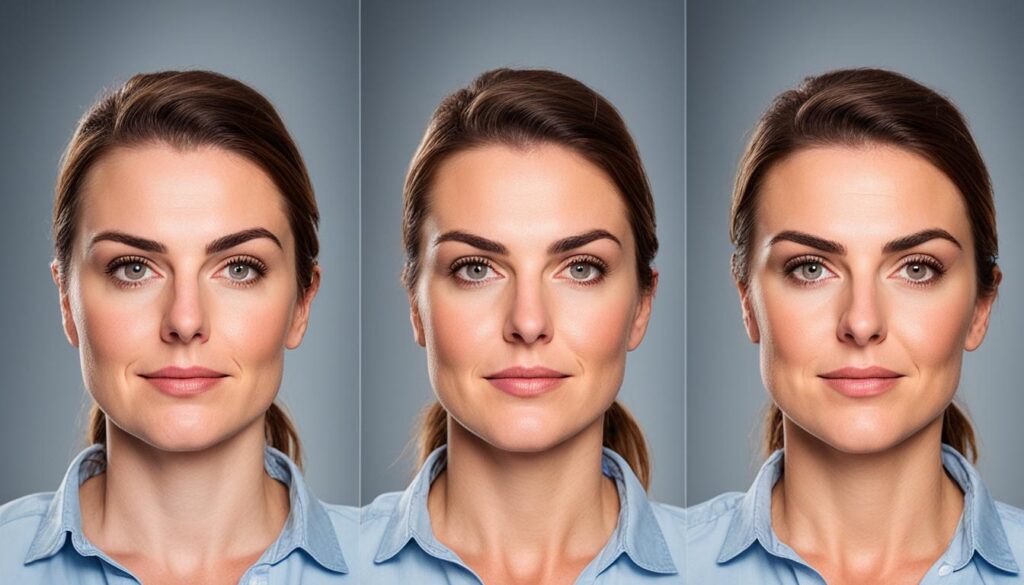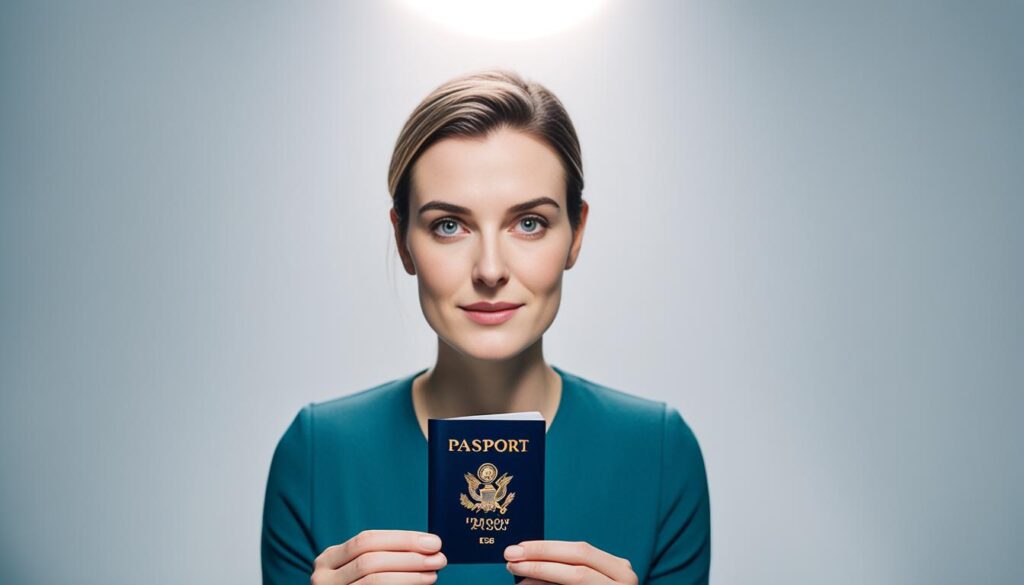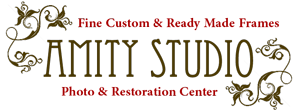Ever thought how changing the lighting can affect your passport photo? Getting the lighting right is key to a photo that looks good and shows who you really are. We’ll explore how lighting affects your photo quality. This knowledge is vital whether you’re getting ready for a trip or updating your passport photo from home in Queens, NY.
Key Takeaways
- Effective lighting is crucial for compliance with passport photo requirements.
- Proper lighting enhances the clarity and overall quality of your image.
- Understanding lighting techniques can take your DIY photo skills to the next level.
- Photography in natural light can yield better results when done correctly.
- Avoid harsh shadows to ensure a uniform appearance in your passport photo.
Understanding Passport Photo Requirements
Getting your passport photo right is key for a smooth process. Make sure your photo fits the passport photo requirements set by the U.S. government. The photo should be recent, taken in the last six months, to show your current look.
The photo size is also important. It must be 2×2 inches. A light-colored background is best, without shadows. Your face should be easy to see, avoiding glare or reflections. If you wear glasses, make sure there are no reflections on your eyes.
Knowing the photo specifications helps avoid application issues. Check the U.S. passport rules to make sure your photo meets them. A small mistake can cause big delays in getting your passport.
| Requirement | Details |
|---|---|
| Size | 2×2 inches |
| Background | Light-colored and neutral |
| Photo Age | Taken within the last six months |
| Visibility | Face must be clear with no shadows or reflections |
Follow these tips to make your passport application go smoothly and avoid problems.
Importance of Lighting in Photography
Learning about importance of lighting in photography is key for great photos. For passport photos, it’s even more crucial. Bad lighting can hide details and change colors, making your photo not good enough. Knowing photo lighting basics helps you make images that meet official standards.
Lighting affects how we see things. Harsh shadows can change how your face looks, while soft lighting makes you look better. For the best look, make sure your photography lighting setup reduces shadows and highlights your face. This way, your passport photo will show you clearly.
- Diffusion of light: Use softboxes or similar tools to lessen harshness.
- Positioning: Place lights at eye level to avoid unflattering angles.
- Consistency: Ensure that lighting remains uniform across the frame.
Keep these tips in mind to boost your passport photo quality. Understanding the importance of lighting in photography is vital.
| Lighting Type | Characteristics | Best Use Cases |
|---|---|---|
| Natural Light | Soft, ambient light during the day | Outdoor portraits, when positioned correctly |
| Front Lighting | Direct light facing the subject | Clear facial images without shadows |
| Back Lighting | Light behind the subject | Avoid for passport photos; leads to silhouettes |
Characteristics of Ideal Passport Photo Lighting
Your passport photo’s quality depends a lot on the lighting. The best lighting for passport photos is soft and diffused. This type of lighting reduces shadows and highlights, making sure your features show clearly.
When planning your photo session, remember these important points:
- Soft light reduces harsh shadows, providing an even distribution across your face.
- Diffused sources ensure that no glaring spots detract from your overall image.
- No shadows on the background and face is crucial to maintain a professional look.
- Natural color representation allows for true likeness, which is vital for identification purposes.
Following these tips will help you get a high-quality passport photo. It will look great and meet all the official requirements.
| Lighting Type | Characteristics | Advantages |
|---|---|---|
| Softbox | Provides even diffused lighting | Minimizes shadows, ideal for portraits |
| Natural Light | Requires positioning for optimal effects | Gives a fresh and warm appearance |
| Ring Light | Creates a soft halo effect around the subject | Enhances features without harsh shadows |
The Role of Lighting in Your Passport Photo Quality
Lighting is key to a good passport photo. It affects the sharpness, clarity, and color balance of the image. Using the right lighting makes your photo look better and follow the rules.
Bad lighting can cause problems. Shadows might hide your face, and overexposure can blur your features. Knowing how lighting works helps you avoid these issues. This way, your passport photo will look clear and professional.
Here’s a table that shows how lighting mistakes affect your photo:
| Lighting Mistake | Consequences |
|---|---|
| Insufficient lighting | Dark, unclear images that may be rejected |
| Harsh lighting | Overexposed areas that obscure facial details |
| Uneven lighting | Unwanted shadows affecting facial visibility |
| Too much backlight | Subject appearing as a silhouette, making identification difficult |

Choosing the right lighting means your passport photo will show you clearly and meet the rules. Knowing about lighting can help you avoid redoing your photo. This saves you time and trouble.
Setting Up Your Photo Space for the Best Results
Creating a great photo space is key for passport photos. A well-designed space makes your photo clear and focused. It ensures your photo looks good. Here are some tips to make the perfect setting.
Selecting the Right Background
Your background is very important for your passport photo. Choose a neutral color like white or off-white. These colors help keep your face the main focus. Stay away from bright patterns or textures that might distract from your face.
Creating a Clutter-Free Environment
Keeping your photo area clean is crucial for a professional look. Remove any objects that take away from your face. This means furniture, decorations, or anything else not needed in the photo. A clean space makes your photo look better and shows you off well.
By choosing the right background and keeping the area clean, you can make a great photo space. These steps help make sure your passport photo looks good and meets all the requirements.
Lighting Techniques for Passport Photos
Getting the perfect passport photo means knowing how to use lighting well. The way light hits your face affects the photo’s quality. Front lighting is key for making your face look clear and bright. But, you also need to watch out for backlights, as they can cause bad shadows.
Using Front Lighting Effectively
Front lighting makes sure your face is evenly lit. This method cuts down on shadows that could hide your features. Here are some tips for using front lighting right:
- Place your light source right in front of you for even lighting.
- Soft, diffused lighting helps reduce harsh shadows and looks better.
- Using lights from different angles can improve your photo even more.
Avoiding Backlight in Your Setup
It’s important to manage backlighting to keep your passport photo clear. Backlighting can make shadows dark and hide your face. Here’s how to avoid these problems:
- Make sure all lights are in front of you, not behind.
- Take test shots to see how the lighting changes your photo.
- Adjust your setup so background light doesn’t affect your look.
| Lighting Technique | Effect on Image Quality | Recommendations |
|---|---|---|
| Front Lighting | Makes face look even, cuts down shadows | Use soft, diffused light sources |
| Backlighting | Creates shadows, makes face hard to see | Avoid lights behind you |
Natural Light Photography Tips
Using natural light in photography can make your passport photos look better. Knowing how to work with the best natural light changes your images. It makes them look more flattering and professional.
Choosing the Right Time for Natural Light
The timing of your photo shoot is key for great results. The best times are early morning or late afternoon when the light is soft. Overcast days are also good because clouds soften the sunlight. This reduces harsh shadows and lights your face evenly.
Positioning Yourself Near Windows
Being near a window can greatly improve your photos. Stand close to a window to get lots of natural light. Make sure the light falls evenly on your face. Avoid direct harsh light from a window by using curtains to soften it if needed.
| Time of Day | Light Quality | Best Practices |
|---|---|---|
| Early Morning | Soft and warm | Position yourself facing the window for even lighting. |
| Late Afternoon | Soft and golden | Avoid strong sunlight; look for shaded areas. |
| During Overcast | Even and diffused | No need for additional lighting; perfect for passport photos. |
Follow these tips for natural light photography to make sure your passport photos look good. Pay attention to the time and where you stand near windows. Try different setups to see what works best for you.
Artificial Lighting Solutions for Passport Photos
When natural light isn’t available, artificial lighting can help get you a great passport photo. Choosing the right lighting solutions is key to a clear and professional look. Using several light sources, like lamps placed carefully, creates a soft, even light. This is crucial for good photo lighting.
To prevent harsh shadows and unwanted highlights, keep these tips in mind:
- Choose soft light bulbs that mimic natural light.
- Position your artificial lights at a 45-degree angle from your face to reduce shadows.
- Use reflectors to bounce light back onto your face for even illumination.
Setting up your space correctly is crucial. Here’s a table with effective artificial lighting setups:
| Light Position | Type of Lighting | Purpose |
|---|---|---|
| Front | Softbox or LED Panel | Makes your face look even |
| Side | Desk Lamp with Diffuser | Adds depth and prevents a flat look |
| Rear | Uplight or Window Light | Creates a clear background |
By mixing different artificial lighting sources, you can get the best results for your passport photo. Focus on the light’s quality and where it comes from to remove distractions and improve your look. Working on the lighting setup will make sure your passport photo looks great.

Common Mistakes in Passport Photo Lighting
Knowing the common lighting mistakes in passport photos can prevent rejection. Many applicants miss key lighting aspects, causing photo exposure problems and shadow issues. Fixing these mistakes boosts your chances of a successful photo submission.
Overexposed Images
Overexposure is a big mistake in photos. It happens when the light is too strong, making the image look washed out. Photo exposure problems like this can hide your facial features, possibly causing rejection. Use soft, diffused light or natural light to avoid this. If you need artificial light, softbox lights or reflectors work well. Always check your camera settings for the right exposure.
Shadows on the Face and Background
Shadows can ruin a passport photo. They hide your face or distract from the background, which could lead to rejection. Place your light source in front of you, high up to light your face evenly. Don’t put it above or below, as this creates shadows. If shadows remain, try a fill light or adjust your main light source. Aim for a photo that’s evenly lit and meets all requirements.
| Mistake | Cause | Solution |
|---|---|---|
| Overexposed Images | Harsh lighting or incorrect camera settings | Use diffused light; adjust camera settings |
| Shadows on the Face | Improper light placement | Position light source in front, avoid direct overhead |
| Shadows on Background | Close proximity to light source | Distance from background; use a fill light |
Editing Tips for Enhancing Your Passport Photo
Editing is key to making your passport photo look great. It helps you meet the requirements while keeping your photo clear. Using photo editing tips can make a big difference, ensuring you look your best.
Adjusting Brightness and Contrast
Improving your images is easy with brightness adjustments. If your photo is too dark, brightening it makes your face clear and visible. If it’s too bright and lacks details, reducing brightness helps bring out what’s important.
Contrast is also important. Adjusting it helps your face stand out from the background, adding depth. Here’s how to do it:
- Open your image editing software.
- Find the brightness and contrast sliders.
- Adjust them slowly, watching how it changes.
- Make sure your changes meet passport photo standards.
It’s crucial to balance brightness and contrast. Overdoing one can hurt the other, making your photo look bad. Follow these tips to get a polished passport photo.
Professional Services vs. DIY Passport Photos
Choosing between professional services and DIY for passport photos is a big decision. It affects your passport application. Knowing the pros and cons of each option helps you pick what’s best for you.
Professional passport photos are known for their high quality and strict following of rules. Photographers in Queens know how to take pictures that fit all the official requirements. This means you’re less likely to have your photo rejected. Plus, you get photos that show you’re paying attention to details.
DIY passport photos can save you money if you have the right gear and know-how. You can make photos that meet the requirements without spending a lot. But, you must know the exact rules for passport photos. If not, making good photos might take a lot of tries, leading to problems later.
| Aspect | Professional Passport Photos | DIY Photos |
|---|---|---|
| Cost | Higher | Lower |
| Quality Assurance | Guaranteed | Variable |
| Time Efficiency | Quick | Possibly Lengthy |
| Expert Compliance | Yes | No |
| Equipment Needed | Professional Gear | Camera, Lighting |
Both options have their good and bad points. Think about what matters most to you: quality and ease or saving money. This will help you decide which way to go for your passport photos.
Tips for a Flattering Passport Photo
Getting a good passport photo is key to making your application smooth. Start by practicing posing tips that show a relaxed posture. Avoid stiff or unnatural poses. A slight tilt of the head can add depth without changing your look.
Keep your expression neutral. This balance of professionalism and friendliness is what people like to see in passport photos.
Think about what you wear for the photo. Choose clothes that stand out against the background. Neutral colors are usually best, but adding a pop of color can be good if it suits you. This attire advice will make you look better and keep the focus on your face.
Finally, remember the power of natural light for a better passport photo. Stand in a spot with soft, gentle light to reduce shadows on your face. With these tips, you’ll get a passport photo that looks great and meets all the requirements.

